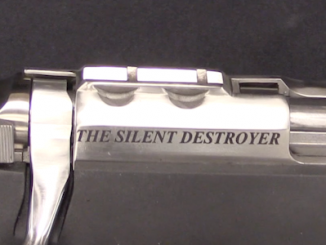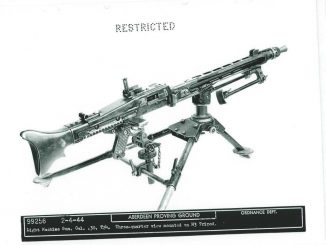So, you would like to get an original AR-10 rifle to shoot? Well, the original Armalite AR10 rifles were almost all manufactured by Artillerie-Inrichtingen in the Netherlands, and they were virtually all machine guns. They were made circa 1960-1961, and only a few contracts were made – Cuba, Guatelmala, Suban, and most notably, Portugal. The Portuguese really liked the AR10 and were planning to adopt it for their whole military, but international pressure for their activity in Angola led to the Netherlands cutting off arms sales, and Portugal only had enough AR10 rifles for its airborne units.
After many years of hard use, these were ultimately replaced by newer weapons, and the surplus guns were found by American importers. In the 1980s, these came into the US as parts kits, which led to a hunt for compatible lower receivers on which to build them. Several small companies made receivers of varying quality before Jerry Drasen and the Sendra company (note the anagram) invested the money to produce a high quality forged and milled 7075 aluminum AR10 receiver, compatible with both Guatemalan and Portuguese pattern rifles. These became the most common and the best regarded AR10 receivers, and that’s what was used to build this particular rifle. This one also has replacement wood furniture, as the original brown Bakelite was relatively fragile.




How does this weapon behave in messy field conditions? I remember the AR-15 did not suffer jamming from mud on the receiver (assuming mud stayed outside the chamber). Anyone up for a trench-condition mud test?
The M-16 wouldn’t pass if stacked against the AK-47. The M-16 had a problem with mud and dirt jamming the receiver due to the close tolerance machining. Not so with the AK which used stamped parts. Furthermore, it is easy to see why our troops preferred the AK in a fire-fight: fast rate of fire, the destruction of the 7.62 for 1 shot, 1 kill and, it wouldn’t jam up from over heating as ours would after firing 3 full magazines, being left to suck your thumb. Sorry guys, AK every time
Lulz. You must not watch Inrange TV.
Agreed. This guy is just a butt-hurt AK fanboy. The AK will operate fine even when dry soil gets into the receiver but trench mud is a different story! And the M-16 wasn’t jammed by mud. The jams came from burned propellant powder residue clogging the gas tube and the bolt!
“M-16 wouldn’t pass if stacked against the AK-47”
I must inform you AK-47 is prototype, similarly to AK-46 and AK-48. Serial production designation is AK, you might call it 56-А-212 if you need to have digits at any price.
“7.62”
AK is just older design, that it is why it has that caliber. 5,56×45 and 5,45×39 represents new generation of cartridge, second is called low-impulse in Russian terminology, meaning easier to use in full-auto mode due to lowered recoil impulse.
http://www.thefirearmblog.com/blog/2016/01/10/5-45×39-small-but-perfect-a-history-of-development/
Also choice of 7.62 in 1940s (against also considered 6.75 caliber) was mainly due to concern with effectiveness of “special” ammunition (armour-piercing, tracer)
“Stamped parts” (receiver?) have nothing to do with them not jamming like M16.
GIs using AKs in Nam is almost a myth, old wives story.
This is real rifle, not ‘matel’ version of it. Wood furniture looks good, but my question is how it behaved in Angola’s humid and hot weather.
If the wood isn’t varnished? Very poorly. I think the Japanese Type 99 bolt-action rifle had a varnished stock to prevent moisture from swelling the wood. I could be wrong, but wood stocks tend not to like extreme weather. Incidentally, is that stock made of walnut wood?
Sport rifles butts are from walnut; that’s what CZ is doing. For military application it can be anything from birch to mahogany. But that is history, mostly. Yeah, you are right, good varnish is the key; after properly kiln-dried blanks.
The Japanese used their time-proven urushi, a traditional finish akin to a lacquer, that most collectores have found very difficult to replicate today (in fact, it is a natural lacquer collected from a tree endemic in Japan and other places in the Far East). You can get serious rash and dermatitis just from light sanding of an original stock…
http://www.eurus.dti.ne.jp/~k-yazawa/urushi.html
What I like about these comments section here is the unbelievable amount of knowledge, ranging from last modern prahistoric people living on some island in Indian ocean, as somebody commented about on some topic before, to this Urushi… Thats great
” last modern prahistoric people living on some island in Indian ocean”
You probably thinks about Sentinelese: https://en.wikipedia.org/wiki/Sentinelese
while probably most known, they are exist other non-contacted:
https://en.wikipedia.org/wiki/Uncontacted_peoples
mostly in South America
“Wood furniture looks good, but my question is how it behaved in Angola’s humid and hot weather.”
I would say that properly made wood is feasible material for rifle stock even for such climates – if this wasn’t cause South American countries would aptly search for other materials for that purpose in second half of 19th century – first half of 20th century.
Take for examples this wooden aeroplane: https://en.wikipedia.org/wiki/De_Havilland_Mosquito
which was (…)operated by the RAF in the South East Asian theatre and by the Royal Australian Air Force (RAAF) based in the Halmaheras and Borneo(…), notice that Borneo is in monsoon if I am not mistaken (rain a lot) and also application as structural element of 1940s military aeroplane is much more demanding than rifle stock.
I did not formulate my question properly. It should have been intended for entire rifle, not just its wooden furniture.
Certainly, there were other rifles such as FAL which served in African continent satisfactorily. I remember there was one man form former Rhodesian military who used it and was happy with it.
The RAF (and the RAAF, if I remember well) experienced serious issues with the wooden structure – and the adhesive used to held it together – of their DH Mosquitos in the SE Asian theatre. This is mentioned in Geoffrey Thomas’ book “Eyes for the Phoenix: Allied Aerial Photo-reconnaissance Operations in South-East Asia, 1942-1945” (Hikoki Publications, 1999
In the heat and high moisture prevalent in India and Burma, the glue, that worked well in temperate and cold (and drier, I suppose) climates, came unstuck…
Denny, the original Portuguese guns had foregrips and stocks made from a sort of fiberglass (painted brown). However, it is known that the Portuguese Air Force produced wooden foregrips for the rifles to replace the original fiberglass ones, which cracked too often.
AR-10s, IIRC, all had plastic furniture. The wood here is an aftermarket addition when these things were assembled on new-production semi-auto lowers for civilian sale in the US in the 80s.
Although trailing behind the FAL (etc) in detailed development terms, the AR-10 did surprisingly well in trials against the FAL, G3, and so on in the late 50s. Second in South Africa, for one. The FAL usually came out on top, but had a head start, being an item since about 1947. The G3 never (I think) came out on top, but was a lot cheaper than the FAL, and quite close in performance.
Ironically, no “first world” nation now uses the FAL, and few the G3. But the AR-10 has been reborn as the SR-25 and L129A1 “sharpshooter” rifles.
I have faith in AR10, good solid gun and as you mentioned it has followup too. I wonder what would be recollections from non-U.S. users, such as Portuguese military veterans. I suppose there are not that many survivors of Angola war left.
More specifically, the Portuguese air force was the user of these rifles. Paratroopers and heliborne/ air mobile troops, which in the Portuguese colonial wars were air force responsibilities just as in WWII Germany the Fallschirmjäger were air force/Luftwaffe troops. Of course, then there is the weird stuff like the Herman Göring panzer division!
From what I have read, the AR10 was popular with those troops–albeit few in number–who used it. The Netherlands was one of the Nato members most opposed to Portugal’s colonial war, and so that is why the AR was not more widely distributed. The army initially showed a preference for the FAL, but opted for the G3 because H und K would help set up the production facility at Braço de Prata…
My understanding is that Brownells is selling a retro Portuguese and retro Dutch AR10 without selective fire features as part of its “retro” AR sales project. There are period-specific ARs built according to the “warts and all” criteria of the given period… No forward assist, three-pronged flash hider wrecked by GIs when used as a pry bar, rate-of-twist for the older M183 55gr. 5.56mm ball… etc.
Really wish I had the funds for this as I prefer rifles with wood furniture.
You don’t mention where to purchase or amount
Uuuhhhh…..Rock Island Auction Company would be
my guess…..
Thanks for the imput. I found that site. It seems is all auctions. You don’t think that they would have like a retail site??
Can’t help with the custom wood furniture… But try Brownell’s.https://www.brownells.com/firearms/rifles/semi-auto/brn-10-retro-rifle-308-7-62-20in-barrel-prod115389.aspx
Looking forward to viewing these videos on PornHub. We’re in a full-on culture war, we shouldn’t give youtube a dime.
Excellent video, as usual. It would be gratifying if you would cover just the differences in large-frame ARs – original Armalite, SR-25, AR-10B, DPMS Gen 1, AR-10A
Why were they still using Bakelite in the Late 50s and early 60s? Surely there were better plastics by then such as glass filled Nylon.
I must give credit to the Dutch for their snowflakery.
By preventing the Portugese from having their AR10s, all they did was close down their own firearms manufacturing facilities. The Portugese got G3s instead, as it seems the Germans did not have the same liberal disdain as the Dutch about arming a fellow NATO member.
Well done, Dutch liberals!
The Portuguese revolution brought the Angolan war of secession to a de facto end,
after that the need for lots of rifles ended. And probably the supply of semi sound currency to pay for them ended as well.
Its possible that in hands of better trained maybe professional troops like these paratroopers gun behaved, but in scenario of adopting it for whole military and regular low skill lazy conscripts, maybe m16 vietnam style problems would resurface.
At 7:45 in the video, the way that Rear Sight is cranked so far to the left; it was either last fired in a heavy cross wind, or not too accurate a rifle !